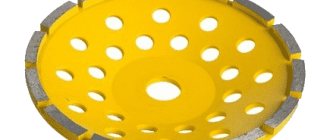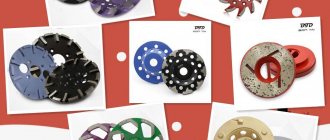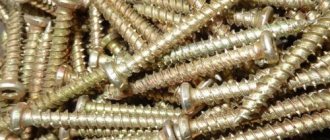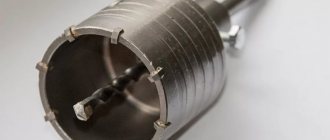Grinding the screed after pouring is a necessary procedure used to level the surface. When processing, special equipment is used - a diamond cup for concrete. Grinding work allows not only to prepare the screed for subsequent coating, but also to strengthen it by removing from the surface the fragile top layer on which cement laitance appears.
Scope of application
The high reliability and wear resistance of the diamond cup make it unrivaled among other equipment for processing hard materials. Using the nozzle, you can scrape and grind concrete, brickwork, stone slabs, porcelain tiles, and paving slabs. Diamond discs are widely used for polishing natural stone - marble or granite. Operations performed using discs include rough, profiled and finishing grinding operations. Diamond cups are used for the following purposes:
- removal of screed sagging;
- roughening;
- alignment of seams;
- grinding joints;
- surface cleaning;
- removal of old or protruding layer;
- final polishing.
When installing attachments on an angle grinder, a dust extractor is usually used or the surface to be treated is moistened with water (wet grinding). This will help reduce dust and make cleaning easier.
Concrete grinding discs are widely used during dismantling work. They effectively remove layers of used glue, hard-to-remove coatings (epoxy, plaster, plaster) and have a long service life. Grinding with a diamond cup saves time: it not only removes unnecessary layers, but also immediately levels the surface.
Types of milling cutters for concrete
Diamond cutters are one of the types of cutting tools that are used to process concrete surfaces using special grinding machines. This tool can be in the form of a disk or an end, cylindrical, end, or key attachment. Mills for grinding concrete are a metal body onto which diamond segments are soldered.
The cutters can have an annular, trapezoidal and triangular shape. Each form is convenient and effective to use. The choice of cutter shape depends on the type of grinding machine.
The round diamond concrete cutter is used in CO type mosaic grinders for processing hard materials such as concrete, paving slabs, marble, etc. It is recommended to use coolant when grinding with this tool.
The triangular diamond concrete cutter is used for processing medium and hard abrasive surfaces . This tool is intended for completing CO type grinding machines. When working with it, cooling is also necessary.
A trapezoidal concrete cutter is also called “Frankfurt” . Such cutters are installed on GM type mosaic grinding machines and are used for grinding concrete, marble, granite, paving slabs, and hard refractories using cooling.
As you can see, diamond grinding tools can be made in different versions, which significantly expands the choice of necessary equipment depending on the requirements of the work being carried out.
Here is a video about diamond grinding discs for concrete:
Design features
Cups for concrete are made of hardened steel with fused small fractions of diamonds. The nozzle is a product consisting of the following elements:
- Round concave base with elements for installation on high-speed electric tools.
- A grinding wheel for concrete, on which segments with diamond fractions are fused.
The bowl-shaped base has holes for cooling during operation. Diamond cutters are located in a circle on the working circumference of the disk, separated by certain intervals (slots). The slots also help cool the cup with air and, in the case of wet processing, with water.
The diamond cup for grinding concrete is attached to the spindle of the grinder using a nut; for this purpose, there is a special hole in the center of the base. Some models have a thread, and the tool can simply be screwed onto the shaft.
Standard sizes and prices
Concrete grinding disc 125 is a circle of metal onto which cutting parts (segments) are soldered . To fix the diamond powder on the segments, a special binder is used - a substance that connects the individual grains together. This bond may be ceramic, metallic or organic. The main task of the bond is to hold the diamond coating, which is subject to the centrifugal force that occurs when the tool rotates. Diffusion sintering is used to connect the diamond layer to the metal body .
The drive designation contains three parameters:
- disk diameter, mm;
- cutting width (working fluid thickness), mm:
- bore diameter, mm.
For example, the designation of the HILTI DC-D 125/22 UP disk is deciphered as follows: 125 is the diameter of the circle, 22 is the diameter of the mounting hole. In this case, the width of the cut is not specified. This means that it is minimal. Mentioning cutting width is usually a marketing ploy . The manufacturer wants to emphasize that his tool is wider and, therefore, stronger. But, in fact, this does not correspond to reality.
Criterias of choice
It can be quite difficult for non-professionals to choose the appropriate grinding tool for their current tasks. To correctly solve this problem, you need to take into account:
- type of material being processed;
- planned grinding depth;
- parameters of the disk itself: number of segments, diameter, rotation speed.
, the concrete grinding disc 125 is most often used , the price of which varies over a fairly wide range and depends mainly on the manufacturer.
Discs with a diameter of 125 are designed for the simplest and most low-power home angle grinders
Price
Approximate prices of diamond blades from different manufacturers:
| Disc diameter, mm | Manufacturer | Cost, rub |
| 115 | Luga Nova | 90-120 |
| Hilti | 280-340 | |
| Bosch | 480-620 | |
| 125 | Luga Nova | 90-195 |
| Hilti | 280-400 | |
| Bosch | 750-1200 | |
| 150 | Luga Nova | 90-220 |
| Hilti | 450-550 | |
| Bosch | 840-1200 | |
| 200 | Luga Nova | 280-350 |
| Hilti | 450-700 | |
| Bosch | 900-1400 | |
| 230 | Luga Nova | 300-400 |
| Hilti | 650-840 | |
| Bosch | 1400-2700 | |
| 250 | Luga Nova | 450-800 |
| Hilti | 1250-2900 | |
| Bosch | 3500 |
The advantage of diamond blades is their wear resistance and strength, as well as the accuracy and high quality of the cut. When using this tool, chips and burrs do not form, even when processing such a durable and porous material as concrete.
Main characteristics
Attachments for grinders vary in size. The most popular standard cup diameter is 125 mm. Other options include diameters from 110 to 180 mm. The power of the tool used to work with the cup must be at least 1500 W. Large nozzles significantly speed up surface treatment, but their cost is higher and they require the use of a more powerful unit. Small-sized products are used by engravers to process workpieces. The diameter of the mounting hole located at the base of the cup varies from 19 to 22.2 mm.
Working elements - cutters - are produced with the addition of small fractions of diamonds to the metal alloy. The mixture is pressed in special forms, which gives it special strength. Large diamond grains (200/160 or 160/125 microns) are used for the manufacture of cutters used for rough processing of concrete surfaces, or roughing. Fine and medium fractions (125/100 and 100/80 microns) are used in the production of finishing attachments.
The advantages of diamond grinding cups for concrete include:
- high strength;
- efficiency;
- durability;
- ease;
- balance.
Builders consider the ability to use a cup without using water to be especially important. The nozzles have special holes on the base that remove air and prevent overheating.
Tips for choosing
The quality and speed of work depends on the nozzle. In addition to selecting technical characteristics, it is necessary to match the mounting holes on the grinding machine and the disk. The standard cup has a circumference of 125 mm. The diameter of the internal hole is 23 mm.
Not only the power of the angle grinder is of great importance, but also the rotation speed. It is necessary to compare 2 characteristics. The instructions should indicate the maximum degree of rotation. This indicator must match the characteristics of the grinding machine. Otherwise, the safety of the work being carried out may be called into question.
Usually an adapter washer is included with the cup. With the help of this simple device, the disc can be placed on different instruments. Grinding is carried out, first of all, rough, and then finishing. It all depends on which model the user purchased.
When purchasing, you need to pay attention to the balance of the disk and its weight. And also look at the heat dissipation rate. Strong heat will shorten the life of the product. If you work under normal conditions, it will last for a long period without losing its original characteristics.
Types of Diamond Cups
According to the manufacturing method, the following types of diamond cups for concrete are distinguished:
- Single row
- Double row
- With continuous sintered diamond layer
Single-row nozzles are characterized by low weight and good performance. Used for final polishing of concrete and creating a smooth edge. A small disadvantage is the difficulty of holding the tool on the surface when diamond grinding concrete.
Double-row discs are used for primary processing of concrete and elimination of visible screed defects. Cups with a circular layer of diamond chips are used for polishing natural stone.
When is concrete grinding needed?
Sanding a concrete wall
After concrete is applied to the floor, an unstable layer forms on its top layer after hardening. From interaction with an external aggressive environment, exposure to mechanical loads, the surface can easily be destroyed.
To obtain a monolithic and durable concrete base, this collapsing layer must be cut off. Diamond cups for grinding concrete help to do this.
In addition, the use of such a diamond disc allows you to solve other problems:
- Grinding the dried concrete screed will make the surface smooth, it will become even, without minor flaws: dimples, tubercles, ripples;
- When grinding concrete that has been in use for a long time, it is possible to remove remnants of the old floor covering and traces of rather complex contaminants from its surface;
- After the process, the water resistance of the concrete surface increases several times;
- The level of dust formation is minimized;
- The strength and resistance of the surface to moisture, harmful chemicals, and temperature changes increases;
- The cost of maintaining the concrete base is reduced;
- A grinder and a diamond cup attached to it for grinding concrete allow you to give a nondescript concrete floor an attractive appearance.
Concrete grinding becomes an indispensable technological process after pouring the floor with self-leveling mixtures, applying various impregnating compounds or thin-layer paints. Grinding is used in commercial and administrative buildings, industrial buildings, and for arranging areas in front of buildings.
Tool characteristics
Diamond blades with a diameter of 125 and 230 mm are used for various types of concrete grinding.
She may be:
- Chernovaya;
- Profiled;
- Finish.
To make cups, a metal alloy and fine diamonds are used. This composition is compressed in special forms. The use of disks for different purposes determines their parameters.
They differ:
- Types of binder;
- Crumb size;
- Location and types of cutters on the cup.
In addition, discs can be: double-row, single-row. More reliable, durable and productive - double-row. But the price of such discs is higher than that of other models.
Shape and number of segments
The quality of the work performed depends on the type and number of segments. There are cups for roughing, rough grinding and for fine polishing of surfaces. According to the shape of the cutters, the nozzles are classified into the following types:
- With double segment
- Square
- Boomerang
- Turbo
- Typhoon
The design of each type provides for a specific arrangement of segments, which affects its operating properties.
Double segment
The Double Segment Diamond Cup is a two-row tool for eliminating large defects in concrete products. Large beads or protruding seams can be easily sanded with this attachment with a good abrasive effect. Segments arranged in a circle in two rows quickly and efficiently process stone or sandstone. Sometimes builders use a nozzle to reduce a thick layer of screed. But with the help of the “Double Segment” it is impossible to achieve ideal smoothness; the screed becomes rough, so for finishing sanding you need to use a different attachment.
Boomerang
The tool received its name due to the similarity of the shape of the diamond segments to a boomerang. The tool is used for finishing concrete grinding, since the cutters use fine-grained diamond chips. After processing, the screed becomes perfectly smooth. The small weight of the “Boomerang” makes it easy to use; it is often installed on an angle grinder because it is light in weight. The popularity of this type of cup is due to its high productivity, which is almost twice that of other types of diamond blades. The choice of this particular tool is also influenced by its lightness and stability.
Square
Diamond cups “Square” are used for roughening concrete surfaces. The effectiveness of the tool allows it to be used to remove large sagging and protruding seams. Diamond cutters are made in the form of squares. The increased thickness of the working segments and the large distance between them make it possible not only to level the surface with roughness, but also to remove any protruding parts on the concrete. Therefore, grinding with the “Square” attachment reduces the time for rough processing of concrete and brick coatings, extending the life of the diamond segments.
Discs for grinding concrete “Square” are heavy, making it possible to process the material with the tool without much effort.
After passing through the diamond cup, the surface remains rough, which gives it high adhesive properties. This is especially important for adhesion to applied coatings, especially polymer ones.
Turbo and Typhoon
The diamond cutters of these attachments are located in a circle on the working surface perpendicular to the direction of rotation. The minimum distance between them creates an almost continuous ring. The appearance of “Turbo” and “Typhoon” disks resembles corrugated fabric. Many segments smoothly polish the surface, so the products are used for finishing grinding of concrete screeds in small areas and for shaped stone processing. Using attachments, you can chamfer and form edges, as well as polish small curves on workpieces.
To perform small operations, you can purchase “Turbo” and “Typhoon” cups of small diameter – from 100 mm. The discs are characterized by wear resistance, high productivity and precision processing.
Surface preparation
Tip: To increase the service life of polished concrete, it should be properly pre-prepared.
Before grinding you must:
- Dismantle the old coating;
- Cut off all large growths;
- Make sure there are no metal fittings exposed to the surface. If there is one, cut it off with a grinder;
- Check the evenness of the surface with a three-meter ruler;
- Carry out an examination of the plane for the size of cracks and seams. If they are available, sealing is carried out using any hand tool with epoxy resin-based mastic;
- The floor and walls are tapped for strength. Refill if necessary.
Repairing Potholes
Repairing a Concrete Wall
Fixing potholes when renovating a room is of great importance. After long-term use, the concrete surface becomes covered with potholes and bumps; their difference exceeds the permissible size of 5 mm. This requires removing defects before grinding begins.
In this case:
- Using a diamond wheel placed on a grinder, the damaged area is cut to a depth of at least 200 mm, and the material is removed;
- The cavity is cleaned from dust with a sandblaster;
- Treated with primer;
- After drying, it is sealed with a special compound;
- Using a lath or rule, the repair mixture is leveled.
After the solution has hardened, you can directly grind the concrete with a circle.
Advice: It is necessary to take into account that if the surface defects are significant, you should carry out the work yourself in several stages, before sanding with a cup.
Small cracks are usually opened in a circle to a depth of 100 mm. The algorithm for performing the work is identical to eliminating potholes, but it is not necessary to remove the damaged area.
Surface grinding
Grinding with a diamond wheel does not correct mistakes that were made in the preliminary stages. It only removes the weakest concrete layer and slightly trims the resulting surface.
Advice: When performing grinding work, you must strictly follow safety precautions. Even a small careless movement can lead to the destruction of concrete and injure a person.
The instructions for carrying out the work are as follows:
- You can turn on the tool only after checking its serviceability;
- The reliability of the bowl is checked;
- The operating time of the equipment is no more than 15 minutes, after which it should be turned off to cool to room temperature;
- It is necessary to take care of a special suit that protects you from the dust that is generated during grinding;
- Measures are taken to ensure timely replacement of cups when they are worn out with similar ones in order to maintain high quality of work.
For mechanical processing of screeds, it is better to use bowls with a diamond grit of at least 400.
How to choose a diamond cup
To produce high-quality processing of a stone or concrete surface, you should carefully consider the choice of a diamond cup. Depending on the type of planned work, the diameter of the nozzle is selected - from 110 to 180 mm. To process small areas where careful sanding is necessary, you need to choose a small cup size. The greatest demand is for 125 mm concrete discs. There are nozzles with a diameter of more than 200 mm. Processing concrete with the help of such a cup is much faster. However, it should be remembered that as the diameter increases, the price also increases.
In accordance with GOST, the diameter of the mounting hole varies from 19 to 22.2 mm. The mounting hole must match the tool that is intended to be used. A loose cup fit can lead to injury and rapid wear of the diamond layer. But usually the attachment kit includes an adapter ring that allows you to use them with tools of different diameters.
All diamond grinding discs for concrete have special markings. It reflects the main characteristics in the following sequence:
- diameter of the outer circle (for example, 125);
- cup depth (40);
- working surface width (10);
- segment height (3);
- mounting hole (22).
All parameters are indicated in millimeters. The brand of diamond powder and the diamond content are specified separately. As a rule, it is 100%, but it can be less or more. Particular attention should be paid to the grain size (for example, 125/100 µm). Large fractions are suitable for rough grinding and roughing work, small fractions are suitable for fine polishing.
The nozzle is selected to match the existing tool. The maximum permissible rotation speed of the disk must correspond to that of an angle grinder, since the safety of work depends on this. Each type of diamond cup has rotation speed restrictions. For example, for double-row cups it is 13,300 rpm.
The weight of the attachment and its balance are also important parameters when choosing a tool. The speed and comfort during surface treatment depends on this.
Device
The diamond cup resembles a metal disc containing diamond coating. Due to this, it has increased strength and hardness. It is capable of processing complex surfaces. Choosing a device is not so easy. To do this, you need to know all the characteristics of diamond cups.
The device is divided into 2 groups. The first option includes circles that have a wide range of applications. The second type includes devices that are more demanding and require special care. The working part is made of bond and diamond coating. If the diamond wears off, the cup will no longer work effectively. In order for it to start functioning again, it must be passed over with an abrasive material.
The same model can have different effects on the materials being processed. If it polishes granite perfectly, then on marble the efficiency will be much lower. You can ruin your work surface. A large number of all kinds of holes and irregularities will appear on it. The product must be selected according to its intended purpose. Thus, models made for working on marble are not suitable for working with granite. The diamond will wear off quickly. Sanding will lose its effectiveness.
Also, grinding cups differ in the diamond fraction. The smaller this characteristic, the more clumsy the product is made. If you need to level out large potholes, it is better to take a disc that has a rough coating. After processing, you will have to sand the surface again, but with a model with a finer fraction. If the surface being treated has a flat base, then you should immediately use a piece with a fine texture.
Working discs also differ in the quality of the diamond. The expensive option will not always be more effective than the cheap one. But often, a budget diamond will wear out faster and sharp jagged edges will appear. The expensive option will definitely last longer. However, when new, both the cheap and expensive options can be equally effective.
Working disks have a different segment shape. A small distance between fractions means a cleaner surface treatment. Such models are recommended for grinding fragile materials. The procedure eliminates the appearance of chips and unevenness. Large distances between segments indicate faster processing. However, the quality of grinding will be slightly worse.
Types of Diamond Wheels
The cups may have a different number of diamond segments. Depending on this parameter, several types are distinguished. Each model has its own narrow specialization and purpose.
Wheels on which the sections are arranged in 1 row are light in weight and highly efficient, but they are very difficult to hold on the surface being processed.
On some models, the segments are arranged in 2 rows. This design is ideal for roughing; it will quickly clean off all roughness and unevenness and carry out rough grinding. To bring the surface to be treated to an ideal state, you will have to use a nozzle with a different coating.
On sale you can see cups of the “square” type. They are heavy and are made for roughing the working surface. During grinding, a chipping effect occurs. This speeds up the process and reduces wear on the diamond blade. Most often they are used to apply roughness and prepare the surface for spraying of polymer material. The “square” design leaves behind a rough plane. This has a positive effect on adhesion with other components.
Models are available for roughing very dense and durable materials. This design is called "Typhoon". With low weight, it has a high margin of strength and wear resistance. Its shape is made in such a way that cut particles are removed at high speed.
Manufacturers present models for finishing materials. This includes the segmented “Turbo” model. Attachments are used in cases where it is necessary to achieve ideal grinding quality. Suitable for creating beautiful edges and chamfers on granite and marble. The cup is used by stone engravers. They make figured monuments from stones. Using the nozzle, you can apply beautiful bends on various products. On sale you can see devices with which precision processing is performed. Their diameter is about 100 mm. Such devices are wear-resistant and will last a long time.
Boomerang discs are designed for fine grinding. The work requires careful handling of the material. They are usually purchased by professionals. The products have many fine-grained diamond elements. This technology allows you to obtain a high quality end result.
Types of fasteners
The work disk must be installed on the power tool. The most common types of fastenings are M14 and M22.2. Most grinding machines have such seats. Some manufacturers present on the market tools with an unusual type of fastener (M16 or M24). This is done for a specific purpose. Owners of such machines will have to buy consumables only from this manufacturer. This fact can hurt your pocket. After all, such products usually cost good money.
Products are available in different circumferences. Before purchasing, you need to make sure that a cup with a certain diameter can be used on your existing grinder.
Purpose of an angle grinder
A grinder, or officially an angle grinder, is an almost universal tool that allows you to perform many operations:
- surface grinding;
- cutting materials;
- cleaning;
- polishing
The main distinctive feature of the angle grinder is the method of installing the spindle, which is installed at an angle to the body. This design allows you to effectively use hand tools as real professional equipment. A variety of materials can be processed with a grinder: wood, stone, brick and concrete.
Features of grinding work
Diamond, as the hardest substance, effectively copes with the most difficult jobs of cleaning and grinding concrete screeds. To perform surface treatment, a diamond alloy cup is attached to the spindle of an angle grinder (grinder). The rotational motion that is transmitted to the disk is approximately 11,000 revolutions per minute. The high power of the tool on which the diamond concrete grinding cup is mounted also increases the productivity of the disc itself.
When working with hard surfaces, consider the following guidelines:
- The correct choice of nozzle in accordance with its purpose will greatly facilitate the processing of concrete.
- Before finishing grinding, rough grinding of edges and sagging is carried out to reduce the load on the disc.
- To break in the cup, it is necessary to carefully break it in in a gentle mode during the first few meters.
- The grinder should be held firmly with both hands to prevent impacts, especially when removing rough protruding defects.
- During operation, the cutter is pressed against the surface, but without increased pressure.
- Do not grind surfaces with breaks or cracks.
- To self-clean the nozzle, effectively cool it and reduce dust formation, it is recommended to supply water to the screed being treated.
- It is strictly not recommended to carry out work during frequent power outages or using faulty tools.
To avoid injury during work, you should use closed shoes made of thick, durable material. Compliance with these simple recommendations will ensure safety during work and extend the life of the diamond cup for construction concrete for an angle grinder.
Why are grinding discs needed?
When concrete hardens, larger components sink lower, and so-called cement laitance remains on the surface. As a result, a lot of dust forms on the hardened concrete, and the concrete surface itself, due to the large number of microcracks, resembles dried out earth. That is why grinding is needed, which eliminates all defects on the concrete base . This operation is performed with special diamond discs.
As practice shows, diamonds, compared to other materials, have higher abrasive abilities and a longer service life. The efficiency of a disk is determined by the quality and speed of processing. These parameters largely depend on the grain size of the disc. Depending on the required level of grinding, a diamond grinding disc for concrete with different concentrations of diamond chips is used .
Sometimes diamond wheels with a sprayed coating of carbide materials are called diamond.
Grinding discs with a high diamond content are used, as a rule, in the preliminary stages of concrete grinding, and with a low concentration - during polishing. For most grinding jobs, medium-concentration discs are used.











